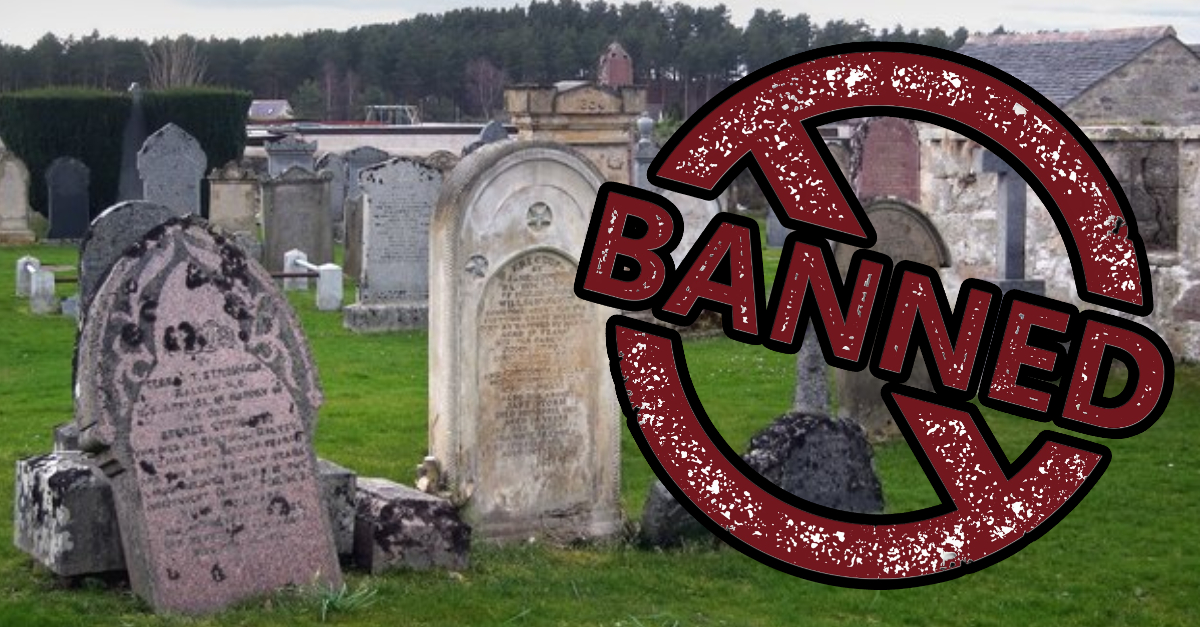You Can’t Die Here
In some towns around the world, dying is technically “illegal.” From frozen Arctic villages to Spanish hamlets with no cemetery space, this slideshow explores those places around the world where death is banned, discouraged, or used as protest.

Longyearbyen, Norway: The Northern Town Where Death Is Discouraged
Tucked away in the Svalbard archipelago, Longyearbyen is the world’s northernmost town—and it’s famous for “banning” death due to a chilling problem with permafrost.
 Chell Hill, CC BY-SA 4.0, Wikimedia Commons
Chell Hill, CC BY-SA 4.0, Wikimedia Commons
Longyearbyen: Why Dying Is Discouraged
Burials were banned in 1950 after officials realized the frozen ground preserved bodies indefinitely. That meant diseases like the 1918 flu virus could survive for decades.
Longyearbyen: There’s No Law Against Dying—But…
There’s no official law making death illegal. However, terminally ill residents are expected to leave the island and receive care—and burial—on mainland Norway.
 Bjoertvedt, CC BY-SA 3.0, Wikimedia Commons
Bjoertvedt, CC BY-SA 3.0, Wikimedia Commons
Longyearbyen: The Cemetery Problem
Longyearbyen’s local cemetery hasn’t accepted new burials in over 70 years. Researchers even found preserved traces of the Spanish flu virus in bodies buried there in 1918.
 Ssu, CC BY-SA 4.0, Wikimedia Commons
Ssu, CC BY-SA 4.0, Wikimedia Commons
Longyearbyen: No Cremation Options, Either
There’s no crematorium in town. So, anyone who passes away must be flown to the mainland for cremation or burial.
 Zairon, CC BY-SA 4.0, Wikimedia Commons
Zairon, CC BY-SA 4.0, Wikimedia Commons
Longyearbyen: Pregnancies Are Also Relocated
Longyearbyen isn’t equipped for childbirth. Expectant mothers are sent to the mainland weeks before delivery to ensure a safe birth.
 Zairon, CC BY-SA 4.0, Wikimedia Commons
Zairon, CC BY-SA 4.0, Wikimedia Commons
Longyearbyen: The Cold Doesn’t Let Go
Due to permafrost, nothing decays properly in Longyearbyen. Waste, food, and even corpses remain intact for years—which does raise pretty serious public health and environmental concerns.
 Zairon, CC BY-SA 4.0, Wikimedia Commons
Zairon, CC BY-SA 4.0, Wikimedia Commons
Longyearbyen: Climate Change Adds New Risks
Warming permafrost may reactivate dormant pathogens, prompting even more caution around old graves—and reinforcing the decision made long ago to ban burials.
 Guillaume Baviere, CC BY-SA 2.0, Wikimedia Commons
Guillaume Baviere, CC BY-SA 2.0, Wikimedia Commons
Longyearbyen: What If Someone Dies Unexpectedly?
Accidents and sudden deaths do happen. In those cases, the body is flown off the island as soon as possible, weather permitting.
 Bjoertvedt, CC BY-SA 3.0, Wikimedia Commons
Bjoertvedt, CC BY-SA 3.0, Wikimedia Commons
Sellia, Italy: A Satirical Law to Promote Public Health
In 2015, the mayor of Sellia issued a tongue-in-cheek decree banning residents from dying—unless they stayed healthy. It was part joke, part health campaign.
 Sellia (CZ) - Castello Medievale - Calabria (Italy) by drone, 3L Studio
Sellia (CZ) - Castello Medievale - Calabria (Italy) by drone, 3L Studio
Sellia: The Mayor’s Unusual Logic
The Mayor’s decree: Mayor Davide Zicchinella issued a decree stating “it is forbidden to get sick in the town,” aiming to encourage health maintenance and regular checkups. Those who attended annual physical exams received a €10 health‑tax exemption. Skipping them could mean higher taxes.
 Sellia (CZ) - Castello Medievale - Calabria (Italy) by drone, 3L Studio
Sellia (CZ) - Castello Medievale - Calabria (Italy) by drone, 3L Studio
Sellia: The Real Goal Behind the Law
The “ban” wasn’t enforceable, but it served as a public health wake-up call in a town with an aging and declining population.
 Sellia (CZ) - Castello Medievale - Calabria (Italy) by drone, 3L Studio
Sellia (CZ) - Castello Medievale - Calabria (Italy) by drone, 3L Studio
Sellia: Law As Publicity and Protest
The law also drew national media attention to rural health issues—and worked as a quirky way to highlight serious demographic trends.
 Sellia (CZ) - Castello Medievale - Calabria (Italy) by drone, 3L Studio
Sellia (CZ) - Castello Medievale - Calabria (Italy) by drone, 3L Studio
Cugnaux, France: A Cemetery Protest in Legal Form
In 2007, the mayor of Cugnaux banned death in protest after being denied permission to expand the town cemetery.
 Abdoucondorcet, CC BY-SA 4.0, Wikimedia Commons
Abdoucondorcet, CC BY-SA 4.0, Wikimedia Commons
Cugnaux: A Bureaucratic Stalemate
The town had no more burial space, and legal roadblocks prevented a solution. So the mayor turned the absurdity into political pressure.
 Abdoucondorcet, CC BY-SA 4.0, Wikimedia Commons
Abdoucondorcet, CC BY-SA 4.0, Wikimedia Commons
Cugnaux: Public Attention, Not Punishment
No one was punished, of course—but the “ban” helped spark conversations in national media and forced state officials to address the issue.
 Abdoucondorcet, CC BY-SA 4.0, Wikimedia Commons
Abdoucondorcet, CC BY-SA 4.0, Wikimedia Commons
Cugnaux: Protest Disguised as Policy
The decree was symbolic, but effective—it used satire to spotlight how local officials were being ignored by higher authorities.
 Paternel 1, CC BY-SA 4.0, Wikimedia Commons
Paternel 1, CC BY-SA 4.0, Wikimedia Commons
Lanjarón, Spain: Another Town That Banned Death to Get Noticed
In 1999, the mayor of Lanjarón declared it illegal to die—until new cemetery space could be approved. It was absurdist activism at its finest.
 Ismael Olea, CC BY 4.0, Wikimedia Commons
Ismael Olea, CC BY 4.0, Wikimedia Commons
Lanjarón: Bureaucracy Meets Mortality
Lanjarón’s cemetery was full, and higher-ups were slow to respond. So the mayor made national headlines with a symbolic—but serious—decree.
 bodoklecksel, CC BY-SA 3.0, Wikimedia Commons
bodoklecksel, CC BY-SA 3.0, Wikimedia Commons
Lanjarón: Tourism and the “Death Ban”
The law drew tourists and journalists, turning the town into a surreal attraction while raising awareness of local administrative dysfunction.
 Felipe Schenone, CC BY-SA 3.0, Wikimedia Commons
Felipe Schenone, CC BY-SA 3.0, Wikimedia Commons
Biritiba Mirim, Brazil: The Mayor Who Tried to Ban Death for Real
In 2005, the mayor proposed a formal law outlawing death until more burial space could be secured. It wasn’t satire—it was desperation.
 Biritiba Mirim - Sao Paulo Brasil - Vista de cima em 4K - FIMI X 8SE, PJM DRONE - 4K AERIAL IMAGERY
Biritiba Mirim - Sao Paulo Brasil - Vista de cima em 4K - FIMI X 8SE, PJM DRONE - 4K AERIAL IMAGERY
Biritiba Mirim: A Cemetery Blocked by Environmental Laws
Biritiba Mirim couldn’t expand its cemetery due to protected land status. So the mayor submitted a bill that “forbade” residents from dying.
 Biritiba Mirim - Sao Paulo Brasil - Vista de cima em 4K - FIMI X 8SE, PJM DRONE - 4K AERIAL IMAGERY
Biritiba Mirim - Sao Paulo Brasil - Vista de cima em 4K - FIMI X 8SE, PJM DRONE - 4K AERIAL IMAGERY
Biritiba Mirim: Fines for Dying?
The bill included mock penalties for relatives of the deceased. While clearly symbolic, it pushed national authorities to act.
 Biritiba Mirim - Sao Paulo Brasil - Vista de cima em 4K - FIMI X 8SE, PJM DRONE - 4K AERIAL IMAGERY
Biritiba Mirim - Sao Paulo Brasil - Vista de cima em 4K - FIMI X 8SE, PJM DRONE - 4K AERIAL IMAGERY
Biritiba Mirim: Absurd Law, Serious Problem
With no room for new graves and no legal solution in sight, the town’s protest-law used absurdity to drive real change.
 Biritiba Mirim - Sao Paulo Brasil - Vista de cima em 4K - FIMI X 8SE, PJM DRONE - 4K AERIAL IMAGERY
Biritiba Mirim - Sao Paulo Brasil - Vista de cima em 4K - FIMI X 8SE, PJM DRONE - 4K AERIAL IMAGERY
Falciano del Massico, Italy: A Cemetery Feud Leads to a Death Ban
In 2012, the mayor issued a decree banning death after the town broke ties with its neighboring municipality—which owned the only cemetery.
 Riding in Falciano del Massico, through the foot hills in Southern Italy, Open Roader Garage
Riding in Falciano del Massico, through the foot hills in Southern Italy, Open Roader Garage
Falciano del Massico: A Territorial Stand-Off
Relations between the towns were so bad, Falciano residents could no longer be buried next door. The decree highlighted the absurdity of the situation.
 Riding in Falciano del Massico, through the foot hills in Southern Italy, Open Roader Garage
Riding in Falciano del Massico, through the foot hills in Southern Italy, Open Roader Garage
Falciano del Massico: Legal Fiction, Real Frustration
The ordinance was unenforceable—but it worked as a protest and brought national attention to a deeply local burial problem.
 Riding in Falciano del Massico, through the foot hills in Southern Italy, Open Roader Garage
Riding in Falciano del Massico, through the foot hills in Southern Italy, Open Roader Garage
Sarpourenx, France: Another Symbolic Stand Against Cemetery Limits
In 2008, the mayor of Sarpourenx, Gérard Lalanne, issued a decree stating: “All persons not having a plot in the cemetery and wishing to be buried in Sarpourenx are forbidden from dying in the commune.” It was a satirical response to land disputes that blocked cemetery expansion.
 France64160, CC0, Wikimedia Commons
France64160, CC0, Wikimedia Commons
Sarpourenx: Bureaucracy Meets Black Comedy
The decree warned of sanctions, but like others, it was meant to pressure higher authorities to act—not to criminalize death.
 France64160, CC0, Wikimedia Commons
France64160, CC0, Wikimedia Commons
Sarpourenx: France’s Death Ban Goes Viral
The decree went global, turning the small village into a media curiosity—and eventually helping officials approve the long-needed cemetery expansion.
 France64160, CC0, Wikimedia Commons
France64160, CC0, Wikimedia Commons
Yomitan, Japan: Burial Delays, Not Bans
Yomitan faces burial constraints due to land scarcity and cultural traditions. While there’s no law against dying, funeral logistics can delay final rest.
The Politics of Space: Death Is a Land Use Issue
Whether in Japan, Italy, or Norway, these symbolic laws point to one truth: real estate for the dead is in short supply.
Satire With a Purpose: What These Laws Reveal
These death bans aren’t about stopping death (not possible...yet)—they’re about drawing attention to red tape, aging populations, broken bureaucracies (and environmental challenges).
 Dquai, CC BY-SA 4.0, Wikimedia Commons
Dquai, CC BY-SA 4.0, Wikimedia Commons
Death as Protest: Making the Unstoppable Unlawful
These symbolic laws turn the inevitable into a legal impossibility—making people notice by legislating the absurd.
 FLYING IN BIRITIBA-MIRIM/SP, Dudu Santos
FLYING IN BIRITIBA-MIRIM/SP, Dudu Santos
Could More Towns Follow?: The Crisis Isn’t Over
As cemeteries fill and infrastructure stalls, more local leaders may follow suit—using mock laws to spark real change.
 FLYING IN BIRITIBA-MIRIM/SP, Dudu Santos
FLYING IN BIRITIBA-MIRIM/SP, Dudu Santos
Dying as a Civic Headache: When Bureaucracy Meets Mortality
From zoning disputes to aging populations, death forces towns to confront their limits—and sometimes inspires surreal solutions.
 FLYING IN BIRITIBA-MIRIM/SP, Dudu Santos
FLYING IN BIRITIBA-MIRIM/SP, Dudu Santos
The Most Ironic Rule: Everyone Still Dies
No town has ever succeeded in stopping death. But some have succeeded in using it to get attention—and results.
Death May Be Inevitable—But Burial Is Not
You can’t avoid dying—but in many places, where and how you’re buried is governed by politics, protest, and, occasionally, satire.
You Might Also Like:












